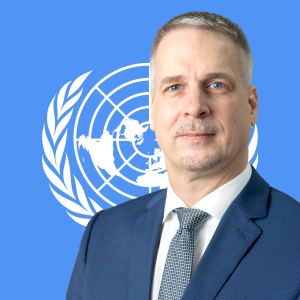RC Remarks at the 10th Meeting of the UN Senior Leadership Group on Disaster Risk Reduction for Resilience
Distinguished Colleagues, Bula Vinaka,
It is a privilege to address this assembly on behalf of the Pacific UN Country Team. The Pacific region is home to some of the most vulnerable and disaster-prone nations and is on the frontline of the climate crisis. Rising sea levels, occurring at more than twice the global average, combined with intensifying climate-related hazards, earthquakes, tsunamis, and volcanic activity, are not distant threats; they are lived realities of compounding risks.
In a region where 95 percent of the population are located within just five kilometers and 50 percent of critical infrastructure within 500 meters of the coastline, the risks are not theoretical; they are immediate and existential.
The challenges faced by Pacific SIDS stem from geographic isolation and dispersion, limited land, and high exposure to natural hazards, compounded by limited economic opportunities and diversification, high levels of debt, and limited resources. In some contexts, social norms continue to marginalize women, and democratic institutions remain fragile.
The Pacific UN Sustainable Development Cooperation Framework 2023–2027 stands as our collective roadmap for sustainable development, uniquely guiding the UN System’s support to 14 Pacific Island Countries and Territories. It aligns with key regional frameworks: the 2050 Strategy for the Blue Pacific Continent and the Framework for Resilient Development in the Pacific.
The Pacific Cooperation Framework embeds DRR as a foundational pillar of sustainable development, prioritizing risk prevention, resilience building, and inclusive recovery. It reflects the region’s unwavering, collective commitment to integrated, locally led, and Pacific-driven development and resilience building.
Over the past years, we have achieved tangible progress in implementing DRR. Allow me to highlight a few key developments from the Pacific region:
In the Pacific, the UN System has played a pivotal role in advancing early warning and anticipatory action, ensuring that communities are better prepared and able to act before disasters strike. Efforts have significantly contributed to the Early Warnings for All (EW4ALL) initiative and the regionally-led Weather Ready Pacific Programme.
Through coordination efforts of UNDRR and UN OCHA, the Pacific Humanitarian Team has transitioned from a predominantly reactive response model to one that prioritizes anticipatory and proactive approaches. This collective UN effort led to the development of the Fiji Anticipatory Action Framework for Tropical Cyclones, funded through CERF, enabling pre-arranged disaster financing and early humanitarian response and its endorsement by the Fiji Cabinet, marking a regional milestone in DRR.
Fiji is also piloting the world’s first anticipatory parametric climate insurance scheme, with support from UNCDF, UNDP, and UNDRR. This innovative model enables farming communities in Fiji to access critical resources in advance, allowing them to take pre-emptive measures and reduce the potential impact of disasters.
Localized DRR implementation in the Pacific is crucial to leave no one behind: In 2024 alone, over 10,000 people were reached through risk awareness raising campaigns, and 14 institutions received technical training to improve coordination and preparedness efforts.
In Vanuatu, over 1,400 women and girls led disaster preparedness planning. Tonga expanded humanitarian cash transfers. In the Federated States of Micronesia, over 790 people across 30 islands were trained on the “Build Back Better” approach and tabletop exercises, with nearly 200 participants, improved disaster preparedness by 62% across key sectors.
While progress is evident, much remains to be done. The strong role of regional organizations in resilience efforts is a major asset, but deeper alignment, joint planning, and resource coordination, remain complex in practice.
To further advance DRR implementation in the Pacific, I propose four key actions, aligned with the Geneva Call to Action and the Compromiso de Sevilla:
First, scale up DRR financing in Pacific SIDS: Pacific SIDS face significant gaps in adaptation and risk reduction funding. Economic losses and damages from the tropical cyclone Pam in 2015 and the volcanic eruption in 2022 in Tonga were equivalent to 64% of Vanuatu’s and 36% of Tonga’s GDP.
It is hence essential, that we unlock new sources of concessional finance, insurance mechanisms, and risk-informed investments. We must make access to international financing more accessible and responsive.
Second, move from siloed systems to integrated planning: DRR must be embedded across sectors and budgets, from education and health to infrastructure and food systems. Platforms like the Pacific Humanitarian Team and the Pacific Resilience Partnership are vital for coordination and shared learning.
Third, invest in data and technology: Better, disaggregated disaster data leads to better decisions. Through recent consultations with governments and civil society across the region, we are shaping the next cycle of Country Implementation Plans, translating the Cooperation Framework into tangible national actions. A consistent message has emerged: the need to strengthen data systems, data sharing and dissemination and harness technology as cross-cutting enablers of effective DRR.
And last but not least, promote inclusive, local leadership: We need to scale up investing in local capacity, and continue training women, youth, persons with disabilities and community leaders to drive resilience from the ground up. Sustained engagement is essential to ensure that DRR respects and protects the rights, cultural values, heritage, and traditional knowledge of Pacific peoples.
Colleagues, the Pacific may be small in landmass, but it is vast in leadership, innovation, and resilience. As the UN System, our role is to amplify that leadership, support integrated solutions grounded in traditioned knowledge, gender responsiveness, inclusiveness, and human rights, in order to ensure that no one, and no place, is left behind.
We, in the Pacific, are committed to keeping disaster risk reduction at the forefront, not only as a technical agenda, but as a moral imperative and a strategic enabler of the SDGs.
Vinaka Vakalevu.
Speech by



